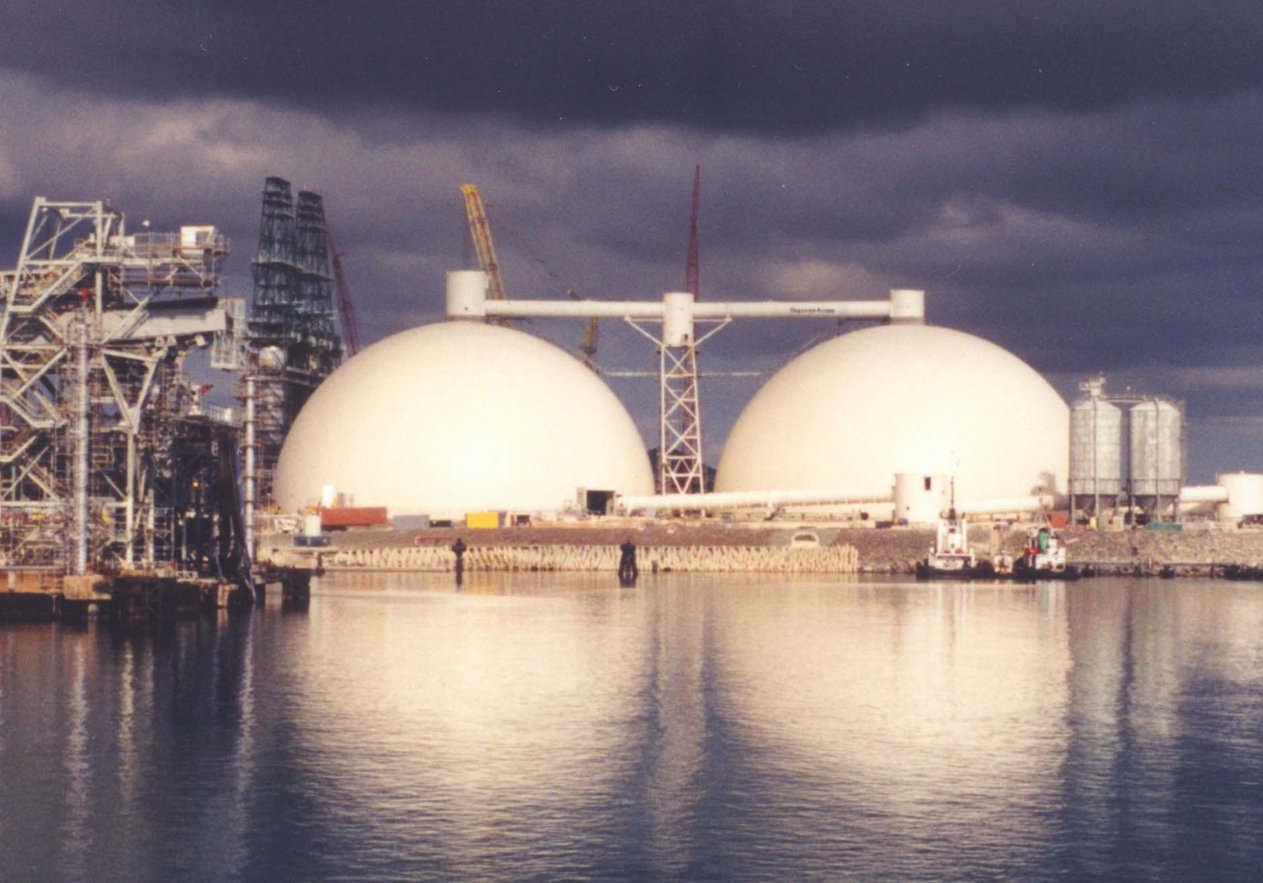
Petroleum Coke Storage — In St. Croix, US Virgin Islands, Hovensa Coker Storage, Bechtel Corp. has two 254′ × 127′ Monolithic Domes. With a capacity of 40,000 metric tons, they’re the world’s largest petroleum coke storages. After this photo was taken, an equipment tower and conveyor system was set on top of the domes. The weight allowance was one million pounds.
Monolithic Dome Petroleum Coke Storages
What is petroleum coke?
Petroleum coke, often called “petcoke,” is a byproduct of oil refineries. Refining crude oil yields gasoline, kerosene, jet fuel, oils and many other products. The final process crude oil undergoes is called coking which produces the solid, carbon material, petcoke. It is highly stable, contains large amounts of energy and is typically used as a fuel source in power plants and for making electrodes for iron mills.
Petroleum coke is an often-ignored byproduct, and in many places, it is merely stored in stacks that grow to towering heights. This means, the petcoke is virtually pure carbon garbage, or close to garbage, at that point and it is being stored in open petcoke piles out in fields near refineries.
What is the problem?
The problems associated with storing petcoke in giant piles can be pretty nasty. As the petroleum coke sits outside, the wind weathers it, creating black dust that flies off into the surrounding areas coating everything. The petcoke dust pollution in Chicago has become such a problem, the City of Chicago created a Petroleum Coke Information page where citizens can educate themselves about the dust and report petcoke observations.
In July, 2013, a storm in the Detroit, Michigan area created a huge cloud of petcoke dust that blew from a pile in Detroit across the river to Windsor. The “petcoke dust storm” was captured on video and published on YouTube:
One woman told me that she could always tell when the wind was blowing across the petcoke piles by the outline of her head on her pillow made by the dark petcoke dust that landed on her pillow during the night. She said it was always disconcerting knowing that an equal amount of petcoke dust landed on her head while she was sleeping and needed to be washed out of her hair and off her face, not to mention how much she had breathed.
More and more refineries are finding that people will no longer put up with the petcoke piles. Recently, The Mining Gazette reported that “The Michigan Department of Environmental Quality announced plans to reject a company’s request to store piles of petroleum coke at an open riverfront site in River Rouge.” They also reported that after residents complained about the giant petcoke piles last year, Detroit’s mayor ordered the black, dusty waste product to be removed from a site along the Detroit River.
What is the solution?
Petcoke storage facilities solve the problems associated with open-air petcoke waste piles and Monolithic Domes make spectacular, super storages for this petroleum coke.
In More About the Monolithic Dome Storages, Freda Parker notes that “Monolithic built its first storage unit in 1976 — a 105′ × 35′ concrete dome to hold Idaho potatoes. Since then, more than 500 Monolithic Dome storages have been built and are in use in nearly every American state and more than 20 foreign countries. Besides potatoes, they store cement, sand, salt, fertilizer, feed, grains, fruits, vegetables, aggregates, carbon, chips, seeds, peanuts, Coke, blasting powder, etc.”
A Monolithic Dome Petcoke Storage is the best solution for a myriad of reasons. Some of which are: Lower construction costs; Basic foundations; Timely construction; Design flexibility; Superior strength; Minimal condensation; Corrosion resistance; Efficient loading and unloading; Ideal bang walls; Easily maintained temperatures; Survivability; Lower insurance premiums and Longevity.
You can read about more of the advantages of building a Monolithic Dome Bulk Storage and details about the construction in my article, Anatomy of a Monolithic Bulk Storage.
What is the bottom line?
The bottom line is that Monolithic Dome Petroleum Coke Storages are the best solution to the problem of storing petcoke out in the open in massive dust-pollution generating piles that is swiftly becoming an unacceptable solution to the American public.
If you know anybody that needs a petcoke storage, simply drop us a note and we will get in contact with them.